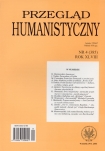Produktywność gatunkowa litanii poetyckiej w XVII i XVIII wieku
Genre Productivity of Poetic Litanies of the 17 and 18 Century
Author(s): Witold SadowskiSubject(s): Cultural Essay, Political Essay, Societal Essay
Published by: Wydawnictwa Uniwersytetu Warszawskiego
Keywords: lament; litania; Stanisław Grochowski; Stanisław Samuel Szemiot; modlitwa; Jacynt Przetocki; Abraham Rożniatowskiego; elogium; preambulum;
Summary/Abstract: In the 17th and 18th century the attendance of poetic litanies in Poland was becoming low. At the same time, the elements of litany were used in other genres: akathist, “godzinki” (Hours – liturgical prayer in the Catholic Church having mostly the nature of intercession. Ranked according to breviary hours, the prayer is not a part of the Liturgy. Should be performed as a choral canon dialogical, but may also be an individual prayer, and recited. Hours are the most common form in honor of Mary, Mother of Jesus), “ogród” (garden – in the Old Polish literature a variety of poetic works of one or several authors, particularly popular in the seventeenth century), lament, eulogy and prelude. The article presents in detail relations between litany and the last three genres. These genres allowed litany to develop innerly and gave it some of their features. When the poetry of the 19th and 20th century again began to use the form of litany, these features started to be treated as poetic litany’s proper features which differed it from litanies from prayer books. For example: from lament, poetic litany took over a trick to replace anaphor of commendation with lamentatory anaphores; from eulogy – the idea to replace the series of God’s apostrophes with the series of reflective phrases. Trans. A. Gierba
Journal: Przegląd Humanistyczny
- Issue Year: 430/2010
- Issue No: 04
- Page Range: 63-74
- Page Count: 10
- Language: Polish
- Content File-PDF

